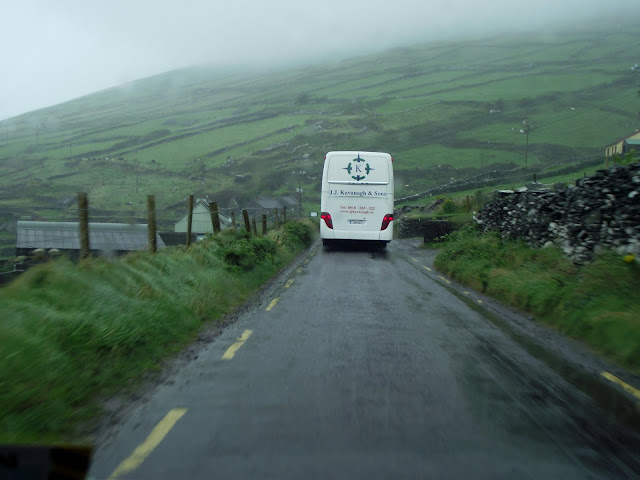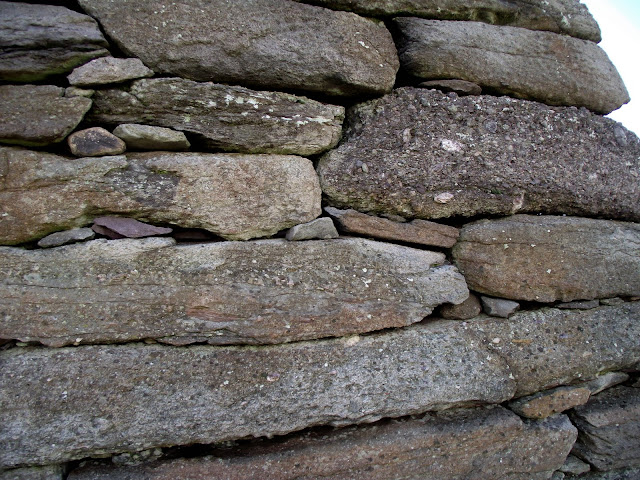The Dingle Peninsula (fortunately or unfortunately, depending on your outlook) is most often ignored by the larger tour companies. Roads are narrow and the terrain can be treacherous--one doesn't just happen onto Dingle, one comes here on purpose. Dingle's population of 10,000 (down from 40,000 before the Irish Famine of the 1840s) clings tightly to its heritage--most notably in those areas that are Gaelic speaking. Signage over the entire peninsula is in Gaelic and, trust me, there is nothing phonetic about it. Dingle hosts many boarding summer schools for "city" kids sent here by parents hoping to keep the olde traditions alive. It's beautiful, it's desolate, it's wild...it's not to be missed.
It is not, however, blue, despite this photo. It was, as you'll soon be able to tell, extremely gray, windy, cold, rainy and foggy during most of our day of touring.
We've had to forget the scenic views of various bays and islands as the low clouds are hanging only a few feet above our car. We do pass numerous ring forts, most of which resemble unrelated piles of stones. We pass by full of regret, but hope to stay fairly dry this morning. The wet(ter) area of the road in the photo above is actually the ford of a stream. I had anticipated a bit more excitement as I read the description in the guidebook. Apparently, the area receives 100 inches of rain a year, so it's only natural that today might be one with rain.
We did venture out of the relative warmth of our tiny car for a closer look at these beehive huts which may date as far back as the Bronze Age. They're found primarily in southwestern Ireland and are relatively common in Dingle. Later huts may date from the Christian era.
This is not a good day to be a seagull. His feathers are fluffed, but he's still not terribly happy. "Free as a bird" does have its downside.
This isn't what I'd call a stormy day because the wind is not close to gale force, but the waves are rushing ashore at Slea Head. We've stopped here for the views of the Blasket Islands (somewhere in the distance), but we leave impressed by the force of the waves and wonder what a real storm might look like.
Did I mention the roads are narrow?
About 22 kilometers into our journey, we left the main road to visit the Great Blasket Centre and, by sheer happenstance (and a desire to get in out of the rain), walked into one of the most fascinating (and touching) afternoons of our trip. The Centre was built in the early 1990s to honor and remember those who lived on Great Blasket Island, just a few miles off the Dingle coast. The island was inhabited from time immemorial by a hardy people who clung to their own language, political system, culture and lifestyle. As late as the 20th century, it would have been possible to live a full lifetime without leaving the island. Over the years, the population dwindled and finally, in 1953, the last of the islanders were brought to the mainland. The sadness of that day and the years that followed is palpable in the islanders' eyes as they are interviewed in a video. The Centre museum is detailed, but never boring. BC and I are museum people, but most others lingered along with us. The stained glass pictured above is only half of a brilliant window wall at the entry of the Centre.
We think we know exactly how this poor devil feels. But considering the seriousness and the sadness of this place...not really.
About ten miles beyond the Centre, we detoured to see the Gallarus Oratory. It was built about 700 CE as an early Christian Church. The stones used to build it (dry-laid, of course) were all slightly slanted to the outside of the building and fitted perfectly so that rain could not get in. To this day, it remains dry inside. The stone work on the inside, filed or chiseled to a fine thickness, is so intricate as to be beautiful. There is one tiny window opposite the door. Amazing!
A close-up of the stones of Gallarus.
We stopped at Kilmalkedar Church (from the 1100's) to wander its large graveyard dating from medieval days to the present. We stopped particularly to view an ogham stone dating from about the 300's CE that, over the years, served as a place to seal a contract. A hole had been drilled through the stone and two people touched thumbs through that hole as they stood on holy ground, thus sealing their contract. We decided to renew our marriage vows through the ogham stone, but before we could accomplish that (us and about fifteen other people who were doing the same thing) a cranky Dingle farmer on a tractor, who was blocked by our not so careful parking, let us know he was having none of that sentimental "sealing" nonsense. We left with our heads hung low as he "putt-putted" up the road.
We finished our tour of the Peninsula and headed back to Dingle Town. Each to his own, of course, but I really liked Dingle. It's "forlorn" feel and the terrain--at least for me--created an authenticity not always apparent elsewhere. Life was hard here and life was real.












No comments:
Post a Comment